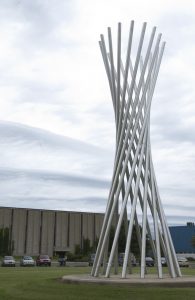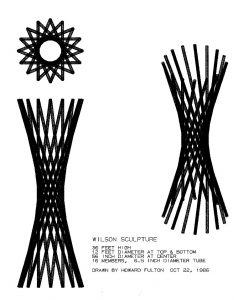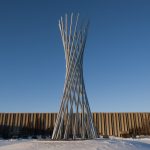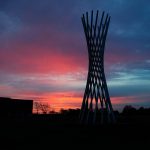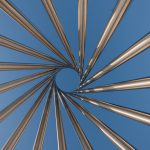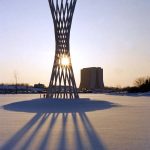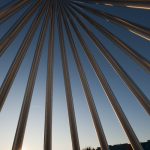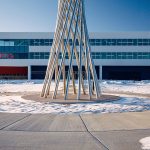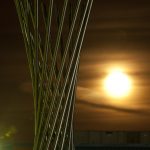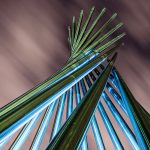This article is dedicated to our dear friend and colleague Gino Bolla.
The Dark Energy Spectroscopic Instrument, called DESI, has an ambitious goal: to scan more than 35 million galaxies in the night sky to track the expansion of our universe and the growth of its large-scale structure over the last 10 billion years. Using DESI — a project led by Lawrence Berkeley National Laboratory — scientists hope to create a 3-D map of a third of the night sky that is more accurate and precise than any other.
A precise map requires that DESI itself be built and assembled with micrometer precision. Fermilab, a Department of Energy national laboratory, is contributing a key piece of the instrument: a large, barrel-shaped device that will hold optical lenses to collect the light from millions of distant galaxies. The smallest deviation in lens alignment could lead to the instrument being permanently out of focus. Every piece of the barrel must be perfectly placed, so the Fermilab team is currently taking every measure to ensure its precise assembly.
The process involves a special machine, meticulous handling and a healthy dose of patience.
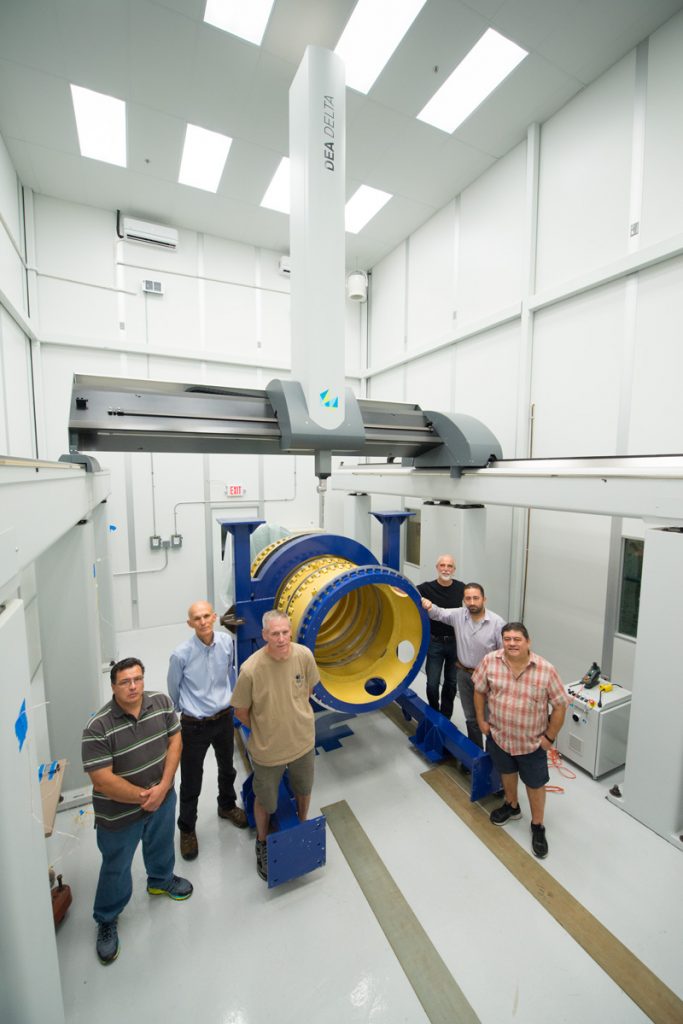
This Fermilab team is currently assembling the barrel for the Dark Energy Spectroscopic Instrument, a project being led by Lawrence Berkeley National Laboratory. From left: Jorge Montes, Mike Roman, David Butler, Gaston Gutierrez, Giuseppe Gallo, Otto Alvarez. Photo: Reidar Hahn
Precision assembly
The lens-holding device is a roughly 8-foot-long and 4-foot-wide segmented cylinder — about the size of a small elevator. Once the hulking steel barrel is complete, it will be installed at the Mayall four-meter telescope at the Kitt Peak National Observatory, southwest of Tucson, Arizona.
The lenses will collect the light reflected from the telescope’s mirror and focus it into 5,000 optical fibers, through which the light is transported to special detectors, called spectrographs. With the help of 10 such spectrographs, scientists can measure the distance of the galaxies.
In May, a team of specialists at Fermilab began assembling the barrel’s five segments carefully, checking that each nut and bolt was perfectly situated. But a nuts-and-bolts-level fit isn’t enough. To achieve the precision scientists are aiming for, the DESI barrel and its inner structure must be assembled accurately to within an incredibly tight 20 micrometers. That’s one 10th of the thickness of a sheet of paper.
To achieve the required fit, the team has been making small, critical adjustments to the assembled barrel.
Accurate alignment
The barrel adjustments take place in a vacant area the size of a small bedroom. Four tall pillars – nearly seven feet high – stand at the corners of the space.
Above their heads, a rail, similar to train tracks, connects the tops of the two pillars on one side. A second rail connects the other two. A moveable carriage track spans the gap – like a high bridge spans a river – connecting the two rails. The carriage itself glides along the track.
The team guides the carriage so that it stops just above the barrel. The carriage carries a mechanical arm that points towards the floor. It can rotate in all directions in the space within the pillars. At the end of the arm is a highly sensitive and precise sensor, fixed to an articulating motorized probe.
The arm with the sensor comes to life: It reaches down to the barrel and starts feeling for its surfaces. It searches for specific points on the barrel – a corner, an edge, another significant surface marker. When it finds them, it measures the coordinates in the designated space. Very carefully and with tiny movements, it moves over the whole surface of the barrel, measuring up, down and around the surface. As it does, it records the measurement data and saves it for further analysis. Jorge Montes, one of the team members, strategically places markers on the barrel’s surface to assist their alignment efforts.
After making the measurement, the scientists return the barrel to an outside area. There they disassemble it, realign all the parts, relying on the previously placed markers. They then reassemble it. With great care they bring the once more fully assembled barrel into the empty space and measure anew the precision of their assembly.
Comparing their performance with their previous assembly, they learn which pieces, if any, are misaligned — even slightly — and where they improved the alignment.
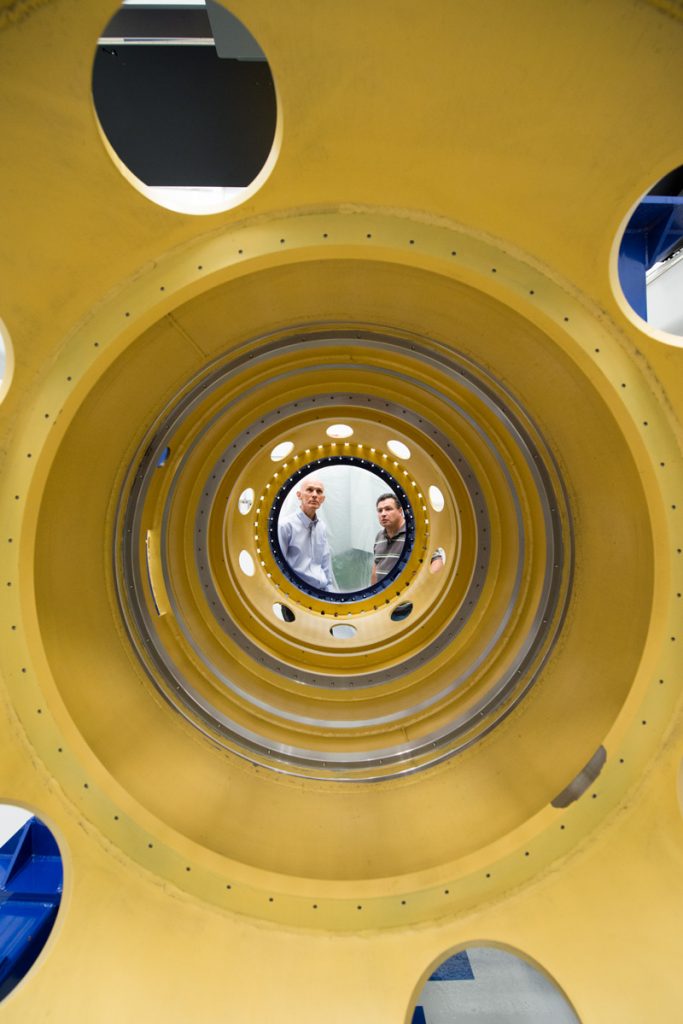
The barrel will hold the lenses and optics for DESI, which will map one-third of the night sky. To create an accurate map, the barrel’s pieces must be accurately assembled to within 20 micrometers. Dial Machine of Rockford, Illinois, manufactured the barrel steel components. Its many tons of steel work were machined to the incredible accuracy required. Photo: Reidar Hahn
A magic machine
The precise, slow-moving measuring machine that points out the misalignments is called a coordinate measuring machine, or CMM. The group making these point-by-point measurements, led by Fermilab engineering physicist Michael Roman, uses it to ensure the DESI barrel’s perfect assembly.
With the help of the CMM, they repeat the whole procedure of assembly, measurement and disassembly again and again, always comparing their performance against previous tries. When they reach their alignment within 10 micrometers — about a 10th the width of a human hair — in a certain number of tries, they are satisfied.
“From early on we knew that the barrel needed high-precision measurements for the assembly and that it would be too large for any of the CMMs at Fermilab to perform such measurements,” Roman said.
“In strong support of DESI, Fermilab bought a machine for the dedicated measurements on the barrel,” said scientist Gaston Gutierrez, who is one of the DESI project leads at Fermilab.
Steady and stable
To ensure that the CMM’s measurements are as precise as they need to be, the CMM is set up in an air-conditioned room, where scientists monitor and control the temperature 24 hours a day. Materials expand when they get warm, affecting the accuracy of CMM’s measurements.
So scientists worked out the right control settings for the environmental control system to ensure that the temperature never varied more than one degree from 20 degrees Celsius.
Even the eventual effect of heavy weights on the DESI barrel, including the lenses, can be measured with the new CMM. Scientists place the DESI barrel in the machine and measure it, then add test weights on its sides and remeasure. The team can see how the barrel shrinks or bends, if at all, and determine whether the lenses will hold steady when the telescope is in motion.
The Fermilab team expects to finish all CMM measurements by early 2017. Then they will disassemble the DESI barrel and send it to University College London. In London, their colleagues will install the lenses in the support structures. Once the lenses are installed, the barrel will start its journey to its future home in Arizona.
Measuring the expansion of the universe
Scientists have discovered that our universe is growing bigger and bigger — without any end in sight. Like raisins in a rising loaf of bread, the universe’s galaxies are being pushed apart from each other.
From previous measurements, scientists have a kind of cosmic ruler, a standard length that goes back to the universe’s early beginning. Using this ruler together with the high-precision DESI map, scientists will be able to tell how far galaxies have moved apart and how much our universe has grown throughout its history.
“With the DESI experiment, we want to follow the growing steps of our universe,” Gutierrez said. “We start from today and go backwards in time to measure how much the universe has expanded since its early days.”
The fabrication, assembly and operation of DESI are small but highly important steps toward precisely understanding the universe.
If it’s true that life begins at 50, Fermilab is just getting started.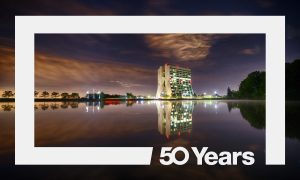
Next year, the country’s premier particle physics laboratory celebrates 50 years of discovery and innovation. Fermi National Accelerator Laboratory, a U.S. Department of Energy lab, was founded in 1967 under the direction of Robert Wilson and in the ensuing half-century has explored many of the most fascinating mysteries of the universe.
Along the way, scientists working at Fermilab discovered three of the elementary particles that make up our universe, photographed the farthest reaches of space to learn more about dark energy and recently received the Department of Energy’s approval to start construction of the largest physics experiment ever built on (and under) U.S. soil, the Deep Underground Neutrino Experiment.
Today Fermilab launched a new website, 50.fnal.gov, with full details of its 50th anniversary celebrations. Highlights include:
- Saturday, Jan. 21: A public kickoff party for our birthday year, featuring a reception in Wilson Hall at 7 p.m. and a concert by Chicago’s own rock ‘n’ roll marching band, Mucca Pazza. Tickets are on sale now.
- Friday, Jan. 27: Fermilab’s Greatest Hits, a lecture by longtime Fermilab scientist Chris Quigg detailing some of the most important moments from the last 50 years. Tickets are available now.
- Sunday, Feb. 12: The annual Family Open House in Fermilab’s Wilson Hall will celebrate the laboratory’s birthday with hands-on science activities for the entire family. This event is free! Watch our website for more information about registering for tours.
- Thursday, June 1: The Fermilab Art Gallery will host an opening reception for “A Lasting Mark: Artist Angela Gonzales at Fermilab 1967-1998,” an exhibit of work from the artist who helped give Fermilab its visual identity. This event is free!
- Thursday, June 15: The day Fermilab employees first reported to work will be commemorated with a social media celebration. Follow Fermilab on Facebook, Twitter and Instagram for more information.
- Saturday, Sept. 23: Fermilab’s big 50th anniversary open house will welcome the public to tour facilities at the lab that they would normally not get to see. The event will include a science and innovation fair and dozens of activities for families. This event is free as well!
That last event is particularly noteworthy. The open house will be the centerpiece of a slate of events at the lab and online that will look back on half a century of achievements and look forward to a bright future.
More events and activities, including pop-up science events in places around Chicagoland, will take place throughout the year. Watch 50.fnal.gov, where more information will be posted as it becomes available.
Fermilab is America’s premier national laboratory for particle physics and accelerator research. A U.S. Department of Energy Office of Science laboratory, Fermilab is located near Chicago, Illinois, and operated under contract by the Fermi Research Alliance, LLC. Visit Fermilab’s website at www.fnal.gov and follow us on Twitter at @Fermilab.
The DOE Office of Science is the single largest supporter of basic research in the physical sciences in the United States and is working to address some of the most pressing challenges of our time. For more information, please visit science.energy.gov.
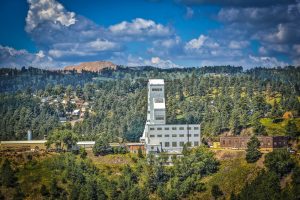
Along with Fermilab in Batavia, Illinois, Sanford Underground Research Facility in South Dakota is the site of the future Deep Underground Neutrino Experiment and its Long-Baseline Neutrino Facility. Pictured here is Ross Shaft. Photo: Sanford Underground Research Facility
The U.S. Department of Energy pursues discovery science that inspires and transforms our nation — research that can sometimes be pursued only in unique environments. The Sanford Underground Research Facility, owned and operated by the South Dakota Science and Technology Authority, or SDSTA, provides one such unique facility, with laboratories located 4,850 feet underground.
Because of the “deep” involvement of both Fermilab and Sanford Lab with the international Deep Underground Neutrino Experiment (DUNE), Fermilab has assumed a new role in the general services that support DOE science at the South Dakota facility.
Starting Oct. 1, Fermilab became the point of contact for the Department of Energy Office of Science at Sanford Lab. In this role, Fermilab is the liaison between DOE and SDSTA. This represents the first time Fermilab has acted in this role for a facility outside Illinois.
“We are excited about this transition as it brings our two organizations into closer partnership and strengthens the platform for some amazing DOE science,” said Tim Meyer, Fermilab chief operating officer.
The change demonstrates recognition by the Department of Energy of the major role Fermilab will play in future Sanford Lab operations. Previously, Lawrence Berkeley National Laboratory acted as the point of contact for DOE at Sanford Lab. Berkeley Lab continues its leading role in dark matter experiments at the South Dakota lab.
Fermilab and Sanford Lab are the sites of the future DUNE international particle physics experiment and the supporting Long-Baseline Neutrino Facility (LBNF).
Fermilab, located in Batavia, Illinois, will send a beam of particles called neutrinos 1,300 kilometers (800 miles) through Earth to Sanford Lab. There, enormous particle detectors, located nearly a mile underground, will receive the neutrinos and send the data to scientists.
Sanford Lab hosts multiple science experiments, of which DUNE is only one. The international Large Underground Xenon dark matter detector, known as LUX, has called Sanford Lab home. The Majorana Demonstrator neutrino experiment, run by a multinational team, is also conducted at Sanford Lab. The Department of Energy, the National Science Foundation and NASA all participate in the science experiments at the South Dakota lab.
As the largest new project being undertaken in particle physics anywhere in the world since the Large Hadron Collider, LBNF/DUNE will be the most ambitious undertaking at Sanford Lab.
“The SDSTA is proud to partner with Fermilab for the continued operations of the Sanford Lab,” said Mike Headley, executive director of SDSTA. “We’ve had a wonderful, productive relationship with Berkeley Lab, which was instrumental in creating the Sanford Lab — the deepest underground science facility in the United States.”
The setting provided by founding Director Bob Wilson’s creative design of the National Accelerator Laboratory, the architecture of the buildings and his many sculptures are an enduring source of pride for those associated with Fermilab and, indeed, for the surrounding community. One of the sculptures that has gained widespread attention is “Tractricious,” a piece that graces the space in front of the Fermilab Industrial Building Complex.
The Industrial Center Building (one of Wilson’s designs) was completed in 1983, when Richard Lundy was head of the Technical Support Section (later renamed the Technical Division). When I became head of Technical Support the following year, I began to consider ways to improve the visual appearance of the space in front of the handsome new building.
We started by moving a large, rather unsightly helium compressor building, then located in front of the Industrial Complex, to a new location behind the industrial buildings. Then in 1986, trees and other landscaping features were added to the front of the Industrial Complex. Still, something was still missing.
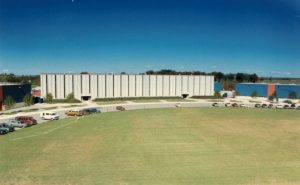
The Industrial Center Building, part of the five building complex, is shown in October 1986 flanked by two of the other industrial buildings. Photo: Fermilab
The area bounded by the new Center Building and the neighboring Industrial Buildings formed an expansive grassy semicircle. The center lines of the three buildings formed a focus at the center of the semicircle. It seemed that this focal point might provide a natural location for a sculpture that would complement the symmetry of the building and the formal style of the landscape plan. It was an ideal location for a “Bob Wilson” sculpture.
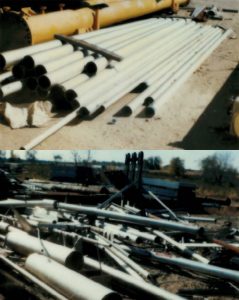
Cryostat pipe left over from the construction of Tevatron magnets was used to build the sculpture “Tractricious.” Photos from the Technical Support files
When I approached Wilson about the possibility of a sculpture, he was enthusiastic. He sent me off to assess the availability of scrap stainless steel that might suggest a theme for the sculpture. Technical support technician TJ Gardner and others searched the places where obsolete, unwanted equipment and scrap materials were kept. We came back with a collection of photos for Wilson of what we thought looked promising (although without the practiced eye of an artist).
Wilson was intrigued by the stainless steel tubing left over from the recently completed construction of the Tevatron superconducting magnets. After assessing the available material, Wilson decided on an array of six-and-a-half-inch diameter stainless steel cryostat tubes in the form of a paraboloid. He considered several designs, including one in which the array was asymmetric vertically, but concluded that it was too suggestive of a cooling tower at a nuclear power plant.
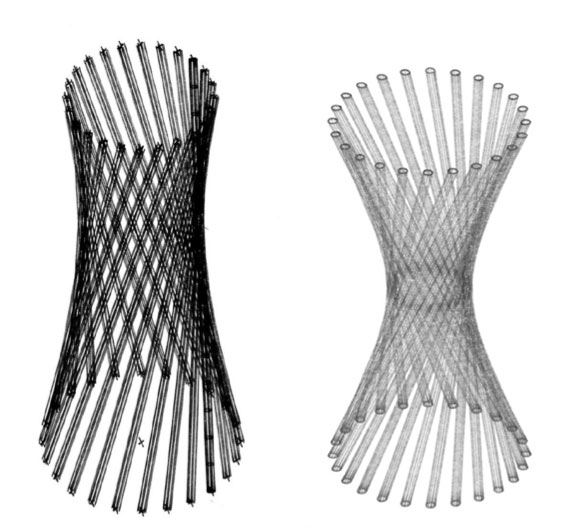
These drawings show early design concepts for “Tractricious.” Drawings from the Technical Support files
Wilson settled on a final design consisting of 16 members, each 39 feet long. The length of each member was achieved by welding two Tevatron cryostat tubes together end to end. The welding was carried out under the supervision of Jerry Peterson and Luis Ramirez in the Technical Support machine shop. The use of cryostat tubes would symbolize the key role the Technical Support Section had played in producing the superconducting magnets for the Tevatron.
Technical Support engineer Tom Nicol went to work designing the pedestal and tube support system. He performed a careful structural analysis, including dynamic response to extreme wind conditions. Tom was confident of the engineering but did tell Wilson that, if the tubes were left open at the top as Wilson wanted, they might fill up with pigeon droppings. Kurt Kasules and George Mikota took care of the pedestal construction and alignment of the tubes.
Wilson derived the name Tractricious from tracktrix, a curve such that any tangent segment from the tangent point on the curve to the curve’s asymptote have constant length, a concept first introduced by Claude Perrault in 1670.
Once satisfied with the design and the name, Wilson began thinking about enhancements. He decided that the sculpture, having a vague resemblance to pipes in an organ, needed to sing with the passing breezes (perhaps inspired by a recently completed sea organ in San Francisco Bay).
Having some familiarity with pipe organs, I thought about that idea for a while and even imagined baffles at different distances from the top of the pipes that might produce different pitches. Alas, in the end the idea turned out to be impractical. Wilson also wanted the base of the sculpture to project above a surrounding reflective pool. While certainly a pleasing addition, the pool ultimately also turned out to be impractical due to our limited resources.
The next hurdle was to find outside funding to construct the pedestal and erect the pipes since these were not normal lab expenditures. I wrote to Stanka Jovanovic, then president of the Friends of Fermilab, appealing for the necessary funding, which we estimated to be about $10,000.
In January, 1987, the Friends of Fermilab Board of Directors unanimously agreed to support raising the funds. Robert Riley, a member of the Friends of Fermilab Board (and president of Gary-Wheaton Bank of Batavia), led the fundraising effort. Riley located interested donors in the community and before long the funds were in hand. The sculpture was completed in June 1988, a tribute, not only to Wilson but to Fermilab’s close relationship to the community.
An attractive feature of the laboratory site, “Tractricious” gets a fair share of photographic attention, as is evident in this gallery. Click on the magnifying glass icon in the lower right to see the photos in their true orientations (landscape or portrait).

